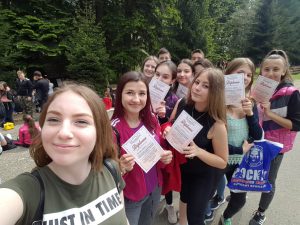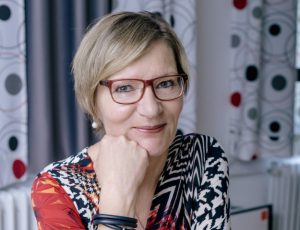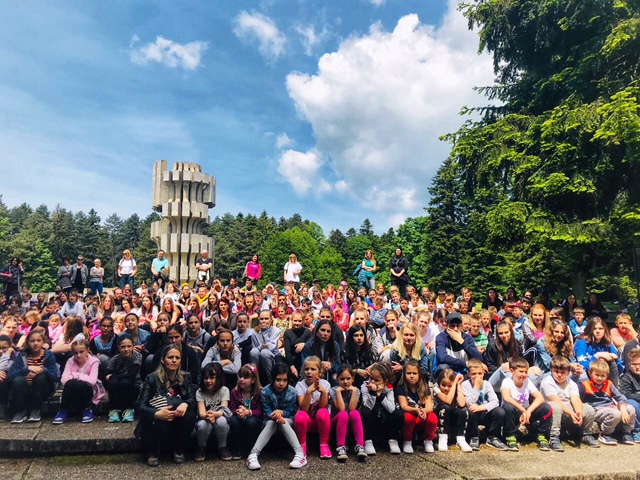
Bosnia-Herzegovina: While children celebrate the cohesion, several politicians play on disunity. Recently, hundreds of children attended a happening in the town of Prijedor.
-To create lasting peace and stability, the cohesion between people must be strengthened, says the Norwegian ambassador Guri Rusten.
-In parts of Bosnia-Herzegovina, children are socialized into specific ethnic groups. In these areas there are challenges such as children attending segregated schools, and some schools are physically divided with high fences.
This is told by Guri Rusten, the Norwegian ambassador to Bosnia-Herzegovina. A peace agreement was signed 24 years ago, but segregation remains a major challenge in parts of the country.
Whether you are Bosniak, Serb or Croat, is often crucial to where you live and choice of political party. Common meeting places are in short supply in many places.
-It is obvious that such a situation will be a challenge if hostile images against other groups are being built up. Hostile images are easier maintained when groups are living separate and do not meet. This is a challenge in parts of Bosnia-Herzegovina, says the Norwegian ambassador on telephone from Sarajevo.
Schools maintains segregation

The segregation is partly maintained by the school system.
-Many of the residents are of mixed ethnicity, but before the children start school, they have to define themselves belonging to a specific group, says Rusten.
At the same time, there are examples of parents, teachers and children protesting against the separate school system. A number of measures and forces work for unity and meeting points. One of them is the Nansen Dialogue Center in the town Prijedor. The center has for many years created meeting places between the various groups of people, and works especially with children and young people. Recently, a large gathering at the Mrakovica Mountain was organized for the ninth time, with 350 students and teachers participating.
-This is a celebration of the multi-ethnic community we want in Bosnia-Herzegovina, says Tanja Milovanovic, the leader of the Nansen Dialogue Center in Prijedor.
-In this way, we promote dialogue, the multicultural and peace-building activities in the primary schools, she continues.
The happening was supported by local authorities, including the mayor of Sanski Most and Prijedor, and a representative from the Norwegian embassy was present.
-We have for many years worked with relationships between people, and we have helped establish and build relationships between institutions such as municipalities and schools, says Milovanovic.
Bringing schools together
Guri Rusten says that the Norwegian embassy in general is very positive to projects and activities that bring children and young people from different ethnicities together.
-Anything that brings groups together, which otherwise are separated, is good. The divisions between the people must be reduced, and the Norwegian embassy supports several projects that address reconciliation, she says.
-The Nansen Dialogue Centers work on bringing schools together, and there are many others who work for common curriculum and common schools. Reconciliation work is absolutely necessary and important, and must continue. The challenges in Bosnia-Herzegovina are not carved in stone, Rusten continues.
Meets headwind from elected representatives
The teacher Draginja Dada Topić has previously said on peace.no that there is less violence at her school in the town of Prijedor, after they have used the Nansen method (article in Norwegian).
The reconciliation work, however, meets the headwind of elected representatives who play on ethnic divisions. At the top political level there is a lot of ethnic rhetoric. There are political parties that are ethnically nationalists, and at the same time there are the multiethnic ones. The majority is ethnically nationalists, but the multiethnic ones are growing.
One hope for Tanja Milovanovic and others that are working for reconciliation in this challenging landscape, is that several media channels pay attention to events that are uniting the people.
-The happening at Mrakovica Mountain received good media attention, with interviews in both national and local TV stations, plus online newspapers, she says.

The Nansen Center for Peace and Dialogue (NCPD) has more than 20 years of experience in developing methodologies, and supporting dialogue projects in the Western Balkans, Afghanistan, Iraq, Kenya, Ukraina, Norway, Poland and other countries. NCPD provides capacity building on dialogue, with trainings, seminars and workshops on dialogue, and is located in Lillehammer, Norway. NCPD has inspired to the creation of several Nansen Dialogue Centers in countries in the Balkans, including Bosnia-Herzegovina.
Text: Kai Eldøy Nygaard
Published in English June 5th 2019